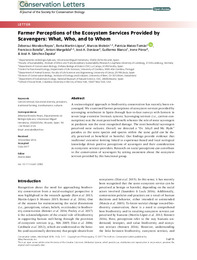Por favor, use este identificador para citar o enlazar este ítem:
https://hdl.handle.net/11000/31056Registro completo de metadatos
| Campo DC | Valor | Lengua/Idioma |
|---|---|---|
| dc.contributor.author | Orihuela Torres, Adrian Antonio | - |
| dc.contributor.author | Pérez-García, Juan Manuel | - |
| dc.contributor.author | Sánchez Zapata, José Antonio | - |
| dc.contributor.author | Botella Robles, Francisco | - |
| dc.contributor.author | Sebastián-González, Esther | - |
| dc.contributor.other | Departamentos de la UMH::Biología Aplicada | es_ES |
| dc.date.accessioned | 2024-02-05T12:33:05Z | - |
| dc.date.available | 2024-02-05T12:33:05Z | - |
| dc.date.created | 2022-07 | - |
| dc.identifier.citation | Ecology and Evolution Volume12, Issue8 August 2022 | es_ES |
| dc.identifier.issn | 2045-7758 | - |
| dc.identifier.uri | https://hdl.handle.net/11000/31056 | - |
| dc.description.abstract | Invasive Alien Species (IAS) alter ecosystems, disrupting ecological processes and driving the loss of ecosystem services. The common carp Cyprinus carpio is a hazardous and widespread IAS, becoming the most abundant species in many aquatic ecosystems. This species transforms ecosystems by accumulating biomass to the detriment of other species, thus altering food webs. However, some terrestrial species, such as vertebrate scavengers, may benefit from dead carps, by incorporating part of the carp biomass into the terrestrial environment. This study describes the terrestrial vertebrate scavenger assemblage that benefits from carp carcasses in a Mediterranean wetland. We also evaluate the seasonal differences in the scavenger assemblage composition and carrion consumption patterns. Eighty carp carcasses (20 per season) were placed in El Hondo Natural Park, a seminatural mesohaline wetland in south-eastern Spain, and we monitored their consumption using camera traps. We recorded 14 scavenger species (10 birds and four mammals) consuming carp carcasses, including globally threatened species. Vertebrates consumed 73% of the carrion biomass and appeared consuming at 82% of the carcasses. Of these carcasses consumed, 75% were completely consumed and the mean consumption time of carcasses completely consumed by vertebrates was 44.4 h (SD = 42.1 h). We recorded differences in species richness, abundance, and assemblage composition among seasons, but we did not find seasonal differences in consumption patterns throughout the year. Our study recorded a rich and efficient terrestrial vertebrate scavenger assemblage benefitting from carp carcasses. We detected a seasonal replacement on the scavenger species, but a maintenance of the ecological function of carrion removal, as the most efficient carrion consumers were present throughout the year. The results highlight the importance of vertebrate scavengers in wetlands, removing possible infectious focus, and moving nutrients between aquatic and terrestrial environments. | es_ES |
| dc.format | application/pdf | es_ES |
| dc.format.extent | 11 | es_ES |
| dc.language.iso | eng | es_ES |
| dc.publisher | Wiley | es_ES |
| dc.rights | info:eu-repo/semantics/openAccess | es_ES |
| dc.rights.uri | http://creativecommons.org/licenses/by-nc-nd/4.0/ | * |
| dc.subject | aquatic-terrestrial interface | es_ES |
| dc.subject | aquatic subsidies | es_ES |
| dc.subject | carrion | es_ES |
| dc.subject | common carp | es_ES |
| dc.subject | nutrient cycling | es_ES |
| dc.subject.other | CDU::5 - Ciencias puras y naturales::57 - Biología::573 - Biología general y teórica | es_ES |
| dc.title | Scavenger guild and consumption patterns of an invasive alien fish species in a Mediterranean wetland | es_ES |
| dc.type | info:eu-repo/semantics/article | es_ES |
| dc.relation.publisherversion | https://doi.org/10.1002/ece3.9133 | es_ES |

Ver/Abrir:
Conservation Letters - 2017 - Morales‐Reyes - Farmer Perceptions of the Ecosystem Services Provided by Scaveng.pdf
653,83 kB
Adobe PDF
Compartir:
 La licencia se describe como: Atribución-NonComercial-NoDerivada 4.0 Internacional.
La licencia se describe como: Atribución-NonComercial-NoDerivada 4.0 Internacional.
.png)